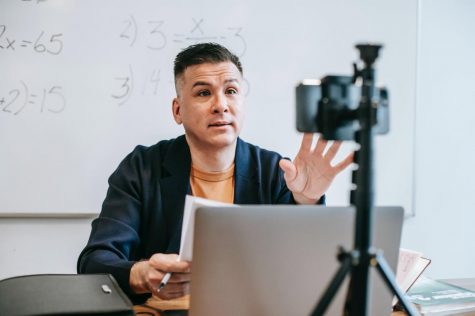Teachers share how students having their cameras off is a challenge
February 12, 2021

In 2020 students had to make major adjustments in light of the pandemic causing students to do school from home. It must be recognized that teachers had to go through this same change also. Virtual learning comes with many challenges, especially for the teachers trying to navigate this new learning format. Putting together lesson plans and teaching through a virtual screen can be hard especially when it’s different than what they are used to.
A challenge that teachers have faced while in this new learning format has been students not turning their cameras on. This can be very difficult for example, Mrs. Pena, says, “It is hard to teach and concentrate when I am just looking at black spaces with colorful dots and initials.”
It seems to be a common opinion among teachers that it can be very strenuous and difficult for them when students keep their cameras off but some of the teachers have said they do understand that there are certain situations that call for a camera to be off. For example, Mr. Belloso, says, “I understand that not all students are comfortable with having their cameras on for a variety of reasons. Some reasons may include but are not limited to, a home environment that they are not comfortable publicly displaying, other responsibilities that they have to tend to during class (ex. babysitting), or self-consciousness about their image.” While they understand these circumstances it can be entirely difficult having a majority of their students have their cameras off if they can have it on.
A big challenge that teachers have to deal with is how they “have absolutely no idea whether or not students are engaged, paying attention, learning, and even present.” Mr. Crisafi says. Students could be video gaming, sleeping, or playing on their phones and the teachers have no idea and this can be worrisome as teachers try to provide an adequate education to their students. Mrs. Yu even says, “I watched one of my students tuck herself/himself back into bed after s/he logged into the meeting.” According to teachers, this is not an unusual occurrence. So to ensure engagement Mrs. Lord, says, “I end up having to repeat myself, hound students for work, and generally take extra measures to get work from students and ensure engagement, since I cannot see if they are on task, working, etc. There is no way to adjust completely, but I use the chat, polls, and other methods of proving engagement. I also monitor student work on collaborative or shared documents.
While doing virtual learning you can not rely on verbal communication like you could when teachers were in the traditional learning setting. In the traditional learning setting, Mr. Engstrom, says, “It is difficult to gauge students’ mood, engagement, and understanding. There are a lot of non-verbal cues that teachers rely on when teaching students and when the students’ cameras are off, we have to try to get a feel for these things through verbal or written communication.” This can be tough for teachers because without reading their student’s expressions they cannot change their approach if necessary, for example; Mrs. Lord, says, “I rely on seeing their reactions to gauge how well they are understanding or to determine whether I need to slow down, speed up, repeat, etc.”
Another challenge they are faced with is “the ability to build a supportive relationship with students,” according to Mr. Belloso. The ways in which he tries to build a relationship with his students in this new work environment is, “having simple, respectful conversations with students (individually and as a group) about the importance of academics. I have contacted students via phone & Remind to just chat about how they are doing. I’ve also simply asked my students for feedback about the class and their needs.” He also has begun a reward system to motivate students and it focuses on “student contribution and collaborative learning,” and they can be entered in the raffle to win prizes like gift cards and snacks which provide motivation towards the students.
Per district policies, teachers cannot make it mandatory for cameras to be on but they still ask that if you can have your camera on that you do so. Teachers work very hard and do their best to put together lesson plans to provide a quality education because they care about their students. So if you can turn your camera on they ask that you please turn it on. Even if it is only half your face. That alone makes a difference. If you cannot turn your camera on due to your situation just make sure to stay interactive with the lesson and stay away from your video games and your bed comforter. You can be interactive by answering questions, asking questions, and giving some sign of life.
